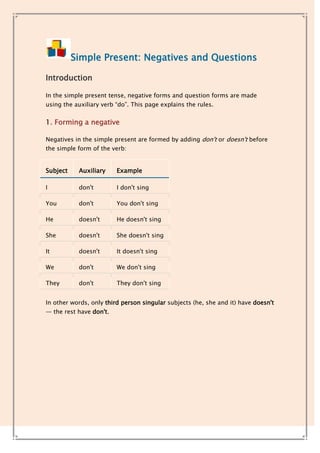Simple present neg and inter grammar
•Download as DOCX, PDF•
0 likes•267 views
This document discusses how to form negatives and questions in the simple present tense in English. Negatives are formed by adding "don't" or "doesn't" before the verb, with the exception of third person singular subjects which use "doesn't". Yes/no questions are formed by placing the auxiliary verb "do" before the subject. WH- questions are formed by placing the auxiliary "do" before the subject and adding the WH- word at the beginning.
Report
Share
Report
Share

Recommended
Phrasal verbs part I 

the Topic of the this ppt: Phrasal verbs
lesson type: Grammar
Level: High school students / foreign learners of English as a foreigh language.
Materials used : pictures including phrasal verbs
what the learner should do first to read the sentences, find the phrasal verbs and then figure out its meaning from the context.
Have: main verb or auxiliary verb

This is a support presentation for the first unit grammar in the English File Advanced Student's Book
Simple present tenses

In this document I have explained about the meaning of "TENSES" and also rule of "SIMPLE PRESENT TENSE" with its examples.
Random Indexing and Quantum Negation for TV-Shows Retrieval and Classification

My final presentation at the end of the internship in Philips Research (Eindhoven)
More Related Content
What's hot
Phrasal verbs part I 

the Topic of the this ppt: Phrasal verbs
lesson type: Grammar
Level: High school students / foreign learners of English as a foreigh language.
Materials used : pictures including phrasal verbs
what the learner should do first to read the sentences, find the phrasal verbs and then figure out its meaning from the context.
Have: main verb or auxiliary verb

This is a support presentation for the first unit grammar in the English File Advanced Student's Book
Simple present tenses

In this document I have explained about the meaning of "TENSES" and also rule of "SIMPLE PRESENT TENSE" with its examples.
What's hot (20)
LL Lower Pri B - Tenses and Aspects of Simple and Continuous Verb Forms

LL Lower Pri B - Tenses and Aspects of Simple and Continuous Verb Forms
Present Simple, present continuous & present perfect 

Present Simple, present continuous & present perfect
Viewers also liked
Random Indexing and Quantum Negation for TV-Shows Retrieval and Classification

My final presentation at the end of the internship in Philips Research (Eindhoven)
negation

Negation powerpoint made for an English class at Córdoba's University . Development of the Plurilingual and Pluricultural Competence.
Negation Expressions in French

A review of common French negation expressions for French 2 NCVPS students.
MODALS PPT

this presentation is on modals,,,and how to use it ,..
done by Nehala IXB Crescent English School
Viewers also liked (11)
Random Indexing and Quantum Negation for TV-Shows Retrieval and Classification

Random Indexing and Quantum Negation for TV-Shows Retrieval and Classification
Similar to Simple present neg and inter grammar
Present simple and present continuous moodle

Theory and exercises on the Present Simple and the Present Continuous tenses.
Presentsimple Vs Present Continous

A description of grammar tenses
Present continous V/S present simple
auxilary-verbs.ppt auxiliary verbs auxiliary verbs

una breve explicacion sobre los verbos auxiliares en ingles
El verbo to have

The Verb To Have. “Have” es uno de los verbos más comunes en el lenguaje inglés. Funciona de varias maneras. Estas son las formas de “to have”
Unit II Present continuous

Cómo realizar oraciones y preguntas, utilizando el presente continuo en inglés.
Helping (auxiliary) verbs english- M. van Eijk

Clear explanation of the basic English helping (auxiliary) verbs
Similar to Simple present neg and inter grammar (20)
auxilary-verbs.ppt auxiliary verbs auxiliary verbs

auxilary-verbs.ppt auxiliary verbs auxiliary verbs
More from cumis2000
More from cumis2000 (11)
Simple present neg and inter grammar
- 1. Simple Present: Negatives and Questions Introduction In the simple present tense, negative forms and question forms are made using the auxiliary verb “do”. This page explains the rules. 1. Forming a negative Negatives in the simple present are formed by adding don't or doesn't before the simple form of the verb: Subject Auxiliary Example I don't I don't sing You don't You don't sing He doesn't He doesn't sing She doesn't She doesn't sing It doesn't It doesn't sing We don't We don't sing They don't They don't sing In other words, only third person singular subjects (he, she and it) have doesn't — the rest have don't.
- 2. 2. Forming a yes/no question Yes/no questions are also created using the auxiliary do. This time, the auxiliary is placed before the subject. Here are the rules: Auxiliary Subject Example Do I Do I sing? Do you Do you sing? Does he Does he sing? Does she Does she sing? Does it Does it sing? Do we Do we sing? Do they Do they sing? 3. Forming a WH- question WH- questions (using words such as “what”, “when”, and “where”) are also created by putting the auxiliary do before the subject. Then, you add the WH- word at the beginning. Here are some examples: Statement Yes/no question WH- question I sing Do I sing? What do I sing? You fight. Do you fight? Why do you fight? He lives Does he live? Where does he live?